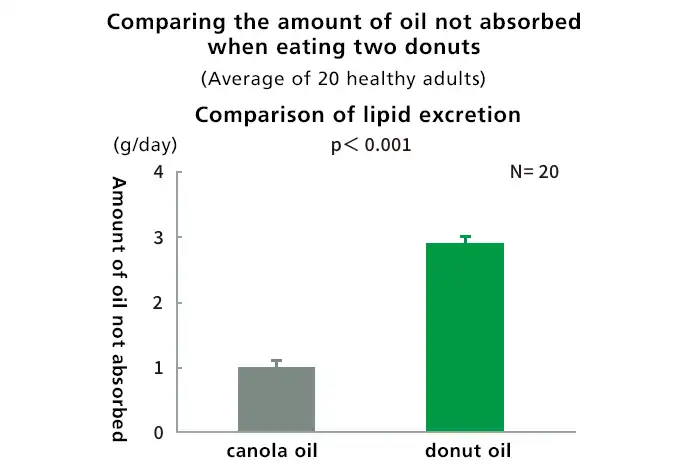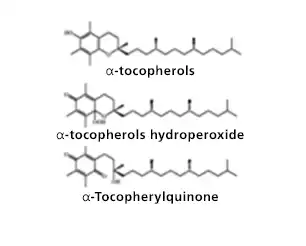Technology development
In order to create new value in terms of Good Taste, health, and low burden, we conduct food science with a focus on oils and starch. We are also working on the development of new materials with a view to solving issues faced by customers and society.
Fundamental technology
Eliminate oiliness
If you feel the so-called "oilyness" that leaves an oily or oily smell in your mouth, Good Taste of food will be halved. By using our unique technology to suppress the production and action of components that cause oiliness and oily odor, we have achieved a "non-oily" texture and flavor, and we have also created products that are suitable for foods. We are working to eliminate oiliness through oil research and development.
Effect of frying oil on donut properties
We identified the important factors that contribute to the deliciousness and texture (oil stains) of donuts, and investigated the frying oil that is suitable for donuts. As a result of evaluating various frying oils, we found that the rising melting point of the frying oil is related to the amount of oil staining on the donuts, and the solid fat content at 30℃ is related to the oiliness and dry texture. It has been found that oils with a rising melting point of approximately 40°C or higher and a solid fat content of approximately 20% at 30°C are suitable for donuts in terms of physical properties and sensory properties.
Furthermore, as a result of evaluating the absorbability of oils with the above characteristics in humans, it became clear that this oil has lower absorbability into the body than Canola Oil (liquid oil).
(Journal of Japan Society of Food Science and Technology 61, 346-352, 2014)

Improving health value
Research results (e.g. research on vitamin K2 intake)
What is vitamin K2 (menaquinone-7)?
Vitamin K was originally discovered as a vitamin essential for maintaining blood clotting, but in recent years it has been discovered that it plays a variety of roles in the body. In particular, it is becoming increasingly important as an essential ingredient for maintaining bone health. The main types of vitamin K that can be obtained from food are vitamin K1, which is found in green vegetables, and vitamin K2 (menaquinone-7), which is found in large amounts in natto.
Calcium for bone health! I think there are many people who say this, but even if you try your best to take in only calcium, it will not reach your bones. This is because the ingested calcium must be transported to the bones and the bone-building protein (osteocalcin) must work effectively. Vitamin K is the only vitamin that can activate this bone-building protein.
Elucidation of the intake amount that produces the effect
Vitamin K2 has been known to activate osteocalcin and benefit bone health, but it was not well understood how much at minimum it should be consumed to be effective. Therefore, with the help of Japanese volunteers, we conducted a study to clarify this question. We found that taking 100 μg of vitamin K2 (menaquinone-7) daily in addition to a normal diet can maintain and improve bone health by preserving the function of bone-building proteins. (Journal of Nutritional Science and Vitaminology Vol. 61 (2015) No. 6 p. 471-480 We J-OIL MILLS were the first to conduct a detailed study in the Japanese population)
In Japan, where the population is aging, fractures caused by osteoporosis are one of the major causes of bedriddenness. In order to maintain and improve bone health, I would like to educate people about the importance of actively taking vitamin K2 and contribute to maintaining health through diet.
Research and development related to safety and security (e.g. trans-fatty acids)
In recent years, with the rise in health consciousness and the accumulation of scientific knowledge, information on lipids has become an important indicator for customers when selecting foods. Trans-fatty acids are one of the risk related to lipids, and in order to provide our customers with even greater peace of mind and safety, we are continually working to reduce trans-fatty acids, which is also in line with guidelines from government and industry organizations.
Generally, margarines are said to be foods that contain a lot of trans-fatty acids, but we have developed and combined the oils and fats that are raw materials for margarines, and utilized our own emulsification technology to improve the functionality of margarines ( We are working to reduce trans-fatty acids while achieving both ease of application and Good Taste. In addition, we are working on reviewing raw materials, material development, and optimizing production conditions not only for margarines but also for other products, and are working to reduce trans-fatty acids so that we can contribute to further peace of mind for our customers. .
Collaboration inside and outside the company
In order to create new value, in addition to our own research, we actively conduct joint research with other research institutions such as universities.
Since April 2019, our company has been holding a joint research course on edible oils oxidation (J-Oil Mills Oil and Fat Innovation Joint Research Course) with Tohoku University Graduate School of Agriculture Science.
In this joint research course,
- To understand the components produced by various oxidation reactions of oils and fats and oils by establishing new analytical techniques for lipid peroxides produced by the oxidation of oils and fats and oils and the secondary oxidation products that result from them.
- To understand the key points of events that occur during oxidation, clarify the points that should be controlled, and explore new application possibilities for oils and fats.
We are working on this as our main objective.
As a result of their research to date, the joint team has developed multiple methods for detailed analysis of oxidized fats and oils, and has succeeded in understanding the complex reactions to a certain extent. In the future, we will further elucidate the oxidation mechanism and the properties of oxides, aiming to establish and strengthen oxidation control technology.
By deepening our joint research with Tohoku University, we will bring out the potential of edible oils and further contribute to "reducing environmental impact" and "maintaining food resources," which we consider to be important issues.
In addition to applying the technologies developed in this way to products in a timely manner, we output the results in the form of academic conference activities and papers, contributing to the advancement of technology in society as a whole.
Analysis of Oxides in oils and fats
oils and fats and oils contain various antioxidants, but it is difficult to understand their behavior. In this study, we succeeded in establishing a method for analyzing trace amounts of tocopherols hydroperoxide and tocopheryl quinone, which are produced by the oxidation of tocopherols (vitamin E), a typical antioxidant found in oils and fats and oils, using a tandem quadrupole mass spectrometer.
This research has enabled us to understand the behavior of antioxidants in oils and fats, which had not previously been understood in detail, and we believe that this will provide important insight into understanding and controlling lipid oxidation.

Title: Analysis of oxidation products of a-tocopherol in extra virgin olive oil using liquid chromatography-tandem mass spectrometry.
Author: Rena Tanno, Shunji Kato, Naoki Shimizu, Junya Ito, Shuntaro Sato, Yusuke Ogura, Masayoshi Sakaino, Takashi Sano, Takahiro Eitsuka, Shigefumi Kuwahara, Teruo Miyazawa, Kiyotaka Nakagawa
Journal: Food Chemistry 306 (2020) 1 25582 DOI: https://doi.org /10.1016/j.foodchem.2019.125582
Initiatives related to intellectual property
Initiatives related to intellectual property are essential to pursuing "Oishisa Design" and delivering happiness to our customers.
At J-OIL MILLS, we position intellectual property activities as essential to our business activities.We have established a specialized organization related to intellectual property in our research and development department, and actively promote the acquisition of rights. We will respond appropriately to infringements of rights based on relevant laws and regulations.
At the same time, we will focus our initiatives on respecting the intellectual property of third parties to avoid infringing on the rights of others.
At J-OIL MILLS, we have positioned the strategic protection of our proprietary technology as a key business objective of our R&D department, and the number of patent applications has increased 1.5 times over the past five years.
- 1. Protection of our technology through intellectual property rights
- We actively apply for patents and aim to acquire rights for inventions obtained through research and development and inventions that are important to our business strategy. To this end, we participate in regular meetings of the technology development organization and discover new inventions.
- 2. Intellectual property strategy planning and business/research strategy planning support
- Utilizing patent maps, we collect, analyze, and evaluate patent information to support the planning of intellectual property strategies and business/research strategies.
- 3. Preventing the risk of infringing on the rights of other companies
- We conduct research before product release and strive to prevent infringement of other companies' rights.
- 4. Education and awareness raising regarding intellectual property rights
- We provide an introductory patent course via e-learning for employees in their first or second year of employment in our technology development organization, and patent study sessions based on certain themes for mid-career employees. We also strive to promote education and raise awareness regarding intellectual property rights by encouraging active participation in external patent courses.
